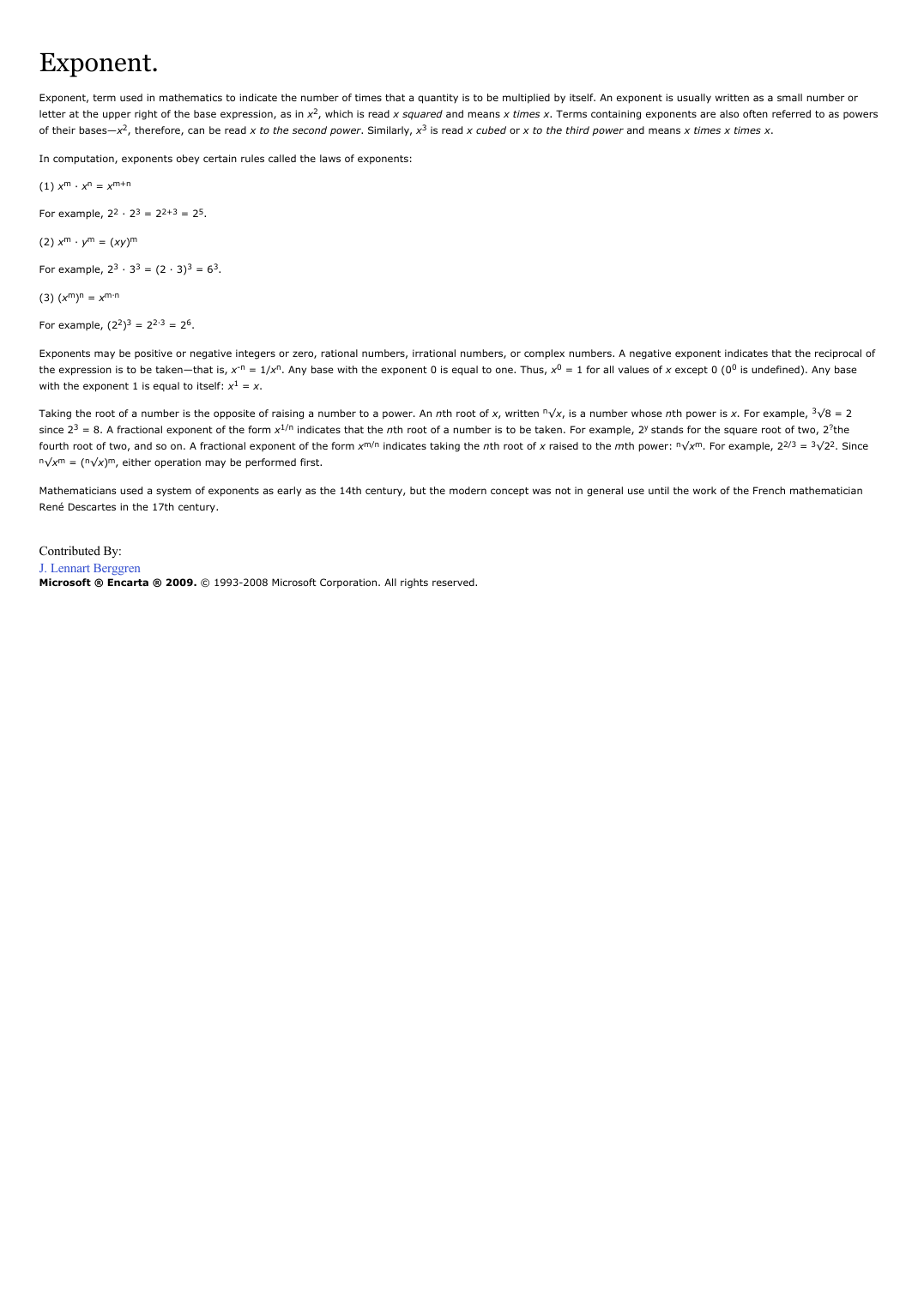Exponent.
Publié le 06/12/2021

Extrait du document
Ci-dessous un extrait traitant le sujet : Exponent.. Ce document contient 382 mots. Pour le télécharger en entier, envoyez-nous un de vos documents grâce à notre système d’échange gratuit de ressources numériques ou achetez-le pour la modique somme d’un euro symbolique. Cette aide totalement rédigée en format pdf sera utile aux lycéens ou étudiants ayant un devoir à réaliser ou une leçon à approfondir en : Echange
Exponent.
Exponent, term used in mathematics to indicate the number of times that a quantity is to be multiplied by itself. An exponent is usually written as a small number or
letter at the upper right of the base expression, as in x2, which is read x squared and means x times x. Terms containing exponents are also often referred to as powers
of their bases--x2, therefore, can be read x to the second power. Similarly, x3 is read x cubed or x to the third power and means x times x times x.
In computation, exponents obey certain rules called the laws of exponents:
(1) xm · xn = xm+n
For example, 22 · 23 = 22+3 = 25.
(2) xm · ym = (xy)m
For example, 23 · 33 = (2 · 3)3 = 63.
(3) (xm)n = xm·n
For example, (22)3 = 22·3 = 26.
Exponents may be positive or negative integers or zero, rational numbers, irrational numbers, or complex numbers. A negative exponent indicates that the reciprocal of
the expression is to be taken--that is, x-n = 1/xn. Any base with the exponent 0 is equal to one. Thus, x0 = 1 for all values of x except 0 (00 is undefined). Any base
with the exponent 1 is equal to itself: x1 = x.
Taking the root of a number is the opposite of raising a number to a power. An n th root of x, written n?x, is a number whose n th power is x. For example, 3?8 = 2
since 23 = 8. A fractional exponent of the form x1/n indicates that the n th root of a number is to be taken. For example, 2y stands for the square root of two, 2?the
fourth root of two, and so on. A fractional exponent of the form xm/n indicates taking the n th root of x raised to the mth power: n?xm. For example, 22/3 = 3?22. Since
n?xm
= (n?x)m, either operation may be performed first.
Mathematicians used a system of exponents as early as the 14th century, but the modern concept was not in general use until the work of the French mathematician
René Descartes in the 17th century.
Contributed By:
J. Lennart Berggren
Microsoft ® Encarta ® 2009. © 1993-2008 Microsoft Corporation. All rights reserved.
Exponent.
Exponent, term used in mathematics to indicate the number of times that a quantity is to be multiplied by itself. An exponent is usually written as a small number or
letter at the upper right of the base expression, as in x2, which is read x squared and means x times x. Terms containing exponents are also often referred to as powers
of their bases--x2, therefore, can be read x to the second power. Similarly, x3 is read x cubed or x to the third power and means x times x times x.
In computation, exponents obey certain rules called the laws of exponents:
(1) xm · xn = xm+n
For example, 22 · 23 = 22+3 = 25.
(2) xm · ym = (xy)m
For example, 23 · 33 = (2 · 3)3 = 63.
(3) (xm)n = xm·n
For example, (22)3 = 22·3 = 26.
Exponents may be positive or negative integers or zero, rational numbers, irrational numbers, or complex numbers. A negative exponent indicates that the reciprocal of
the expression is to be taken--that is, x-n = 1/xn. Any base with the exponent 0 is equal to one. Thus, x0 = 1 for all values of x except 0 (00 is undefined). Any base
with the exponent 1 is equal to itself: x1 = x.
Taking the root of a number is the opposite of raising a number to a power. An n th root of x, written n?x, is a number whose n th power is x. For example, 3?8 = 2
since 23 = 8. A fractional exponent of the form x1/n indicates that the n th root of a number is to be taken. For example, 2y stands for the square root of two, 2?the
fourth root of two, and so on. A fractional exponent of the form xm/n indicates taking the n th root of x raised to the mth power: n?xm. For example, 22/3 = 3?22. Since
n?xm
= (n?x)m, either operation may be performed first.
Mathematicians used a system of exponents as early as the 14th century, but the modern concept was not in general use until the work of the French mathematician
René Descartes in the 17th century.
Contributed By:
J. Lennart Berggren
Microsoft ® Encarta ® 2009. © 1993-2008 Microsoft Corporation. All rights reserved.
↓↓↓ APERÇU DU DOCUMENT ↓↓↓


